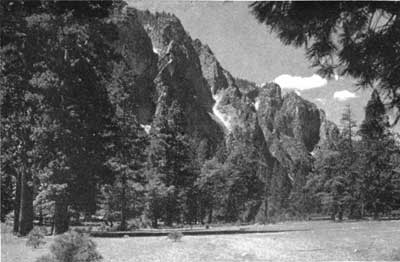MENU
![]() Kings Canyon
Kings Canyon
|
Glimpses of Our National Parks |
 XXVIII
XXVIII

THE KINGS CANYON NATIONAL PARK
CALIFORNIA
Special Characteristic: Some of the Wildest and Most Beautiful Scenery in the United States; Massive Peaks, Glacier Cirques, and Lake-covered Plateaus 10,000 to 14,000 Feet Above Sea-level; Includes the Magnificent Giant Sequoia Groves Formerly Known as the General Grant National Park and also Redwood Mountain, With 7,000 Giant Sequoias, Young and Old
 Scenic view—Kings Canyon National Park |
"WILD as the Himalayas" is the Kings Canyon National Park—a region of superlative, unspoiled mountain wilderness in the heart of the Sierra Nevada. Here the summit peaks of the Sierra are truly magnificent. Rising from valleys some 5,000 feet above sea level, these stupendous mountains, always snow-capped, soar into the clouds to a height of 12,000 to 14,000 feet.
Spectacular granite gorges cut deeply through the main body of the range, leading upward toward the Sierran crests. To the west of the fantastic miles-high wall formed by the towering peaks spread out the shoulders of the range, ridged and valley-spattered, rich with timber-line plateaus.
Through all this lofty magnificence cut rushing streams, leaving in their wake picturesque waterfalls and cascades. Lakes nestle in glacier-sculptured basins, surrounded by meadows and alpine flower gardens.
Establishment of the park in 1940 brought to a happy conclusion a conservation struggle of nearly half a century. In 1891 John Muir, famous naturalist, opened the campaign to preserve the superb scenery of Kings Canyon in a national park and strove valiently to bring about that consummation until his death in 1914. His zeal fired others to enlist in the cause, and the endeavor continued uncreasingly until it ended in 1940 in the triumphant consummation of the park plan. Early in the struggle in 1899, Dr. David Starr Jordan, then president of Leland Stanford University, said of the Kings Canyon:
"I have never seen a more magnificent mountain panorama. I have seen the mountains of this continent from Alaska to Mexico, and I have tramped many mountain miles in the Alps, but such a comprehensive view of mountain masses and peaks and amphitheaters and canyons, of all the details of mountain sculpture on the tremendous scale . . . I have never before seen."
Resembling Yosemite and Sequoia National Parks in general characteristics, the Kings Canyon complements these mountain wildernesses. The basic structure is similar, yet each is distinctive in detail. Each is an essential part of the national park picture.
But one road enters the Kings Canyon National Park, and this reaches into it only a few square miles. Most of this vast wilderness will remain untouched by road, a paradise for the lower of the forest and mountain primeval.
GENERAL GRANT GROVE
The four-square-mile General Grant National Park, established in 1890 to protect two magnificent groves of giant sequoias, was absorbed in the new Kings Canyon National Park. Now known as the General Grant Grove Section, it is administrative headquarters for the great wilderness park of which it is an important, although detached unit.
The venerable General Grant Tree, which gave the grove its name, is so huge that it is difficult to visualize. Its greatest horizontal diameter is 40.3 at the base. In most forests, trees 200 feet tall are giants, yet the General Grant Tree, at 200 feet above the ground, has a diameter of about 12 feet, and reaches upward for yet another 67 feet. It is second only in size to the General Sherman Tree in Sequoia National Park and is one of the most celebrated trees in the United States. Each Christmas Day, services are held in the snowy silence at the base of the General Grant Tree, widely known for a dozen years as the Nation's Christmas Tree. The age of this giant sequoia is estimated at from 3,500 to 4,000 years.
REDWOOD MOUNTAIN
Supplementing the Grant Grove is the newly acquired Redwood Mountain, covered by some 4,000 acres of mountain forest land. The last great grove of giant sequoias remaining under private ownership, over it had fallen the dire shadow of total destruction by commercial cutting, slashing, and dynamiting. Acquisition by the Federal Government and inclusion in the Kings Canyon National Park have saved this mighty grove from that irrevocable fate; for a giant sequoia grove once cut is gone forever. Seedlings may be raised, young trees carefully tended in the hope that they may mature, but a living grove, with forest monarchs thousands of years old surrounded by younger generations, cannot be replaced. The giant sequoias are a survival from another age—an age of giants. Under complete conservation they can be preserved, but never renewed.
On Redwood Mountain may be seen giant sequoias of all ages—seedlings, fine groves of young trees, and some of the oldest and largest of this age-old and giant species. Among these is the widely known Hart Tree.
A striking characteristic of Redwood Mountain is its skyline—for here only may be seen large numbers of giant sequoias silhouetted against the sky. Here also more sequoias show their dome-topped crowns above the balance of the forest than may be seen in any other grove. It is estimated that 7,000 giant sequoias are growing on Redwood Mountain. On just one acre are 7 fire-scarred giants 10 feet or more in diameter and over 200 feet tall.
 Top
Top
Last Modified: Fri, Sep 1 2000 07:08:48 pm PDT
http://www.cr.nps.gov/history/online_books/glimpses1/glimpses28.htm
![]()
